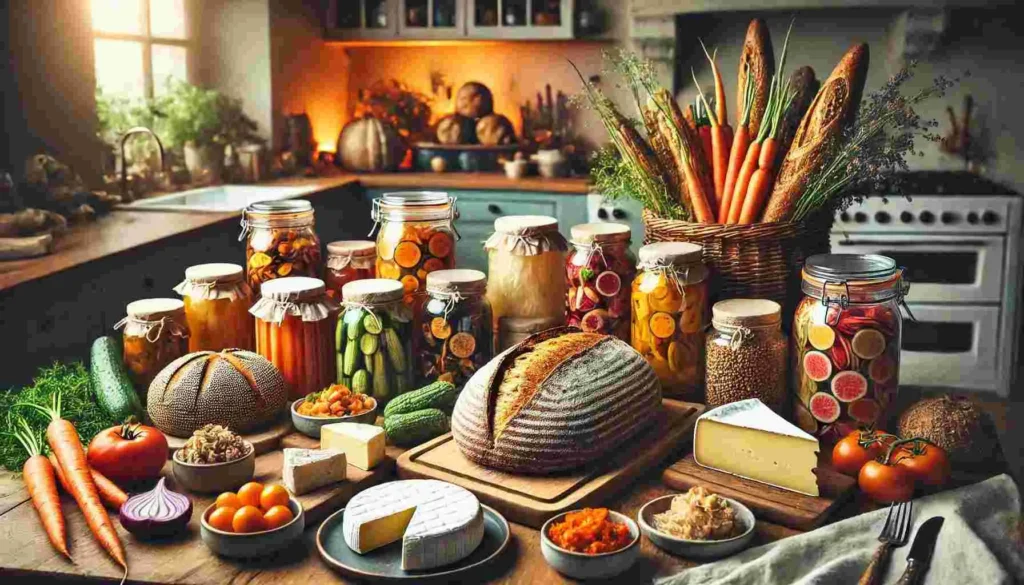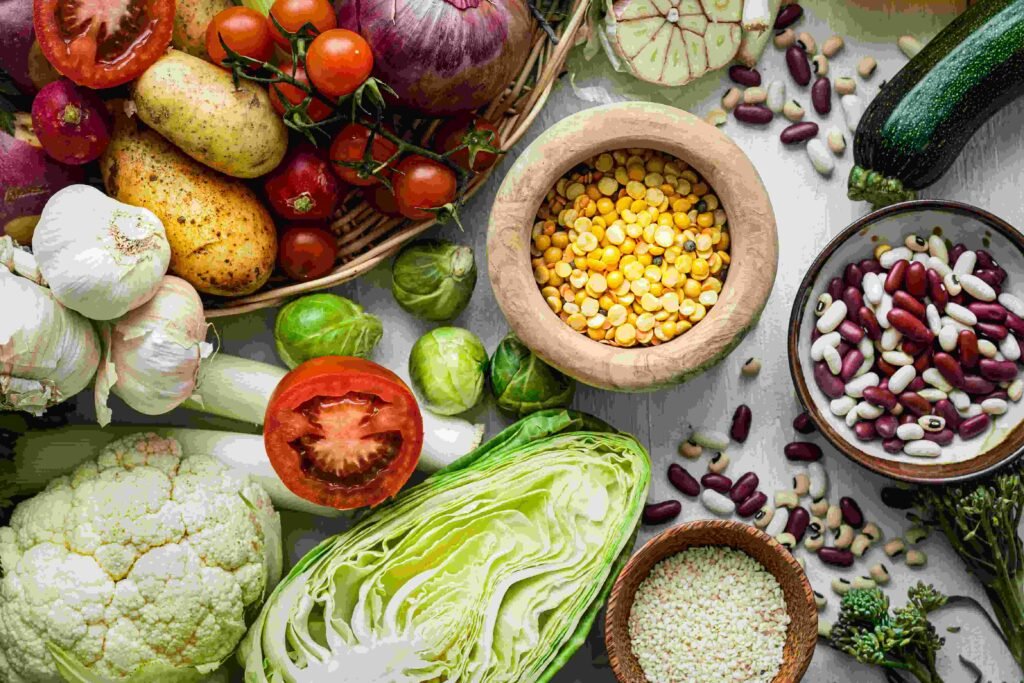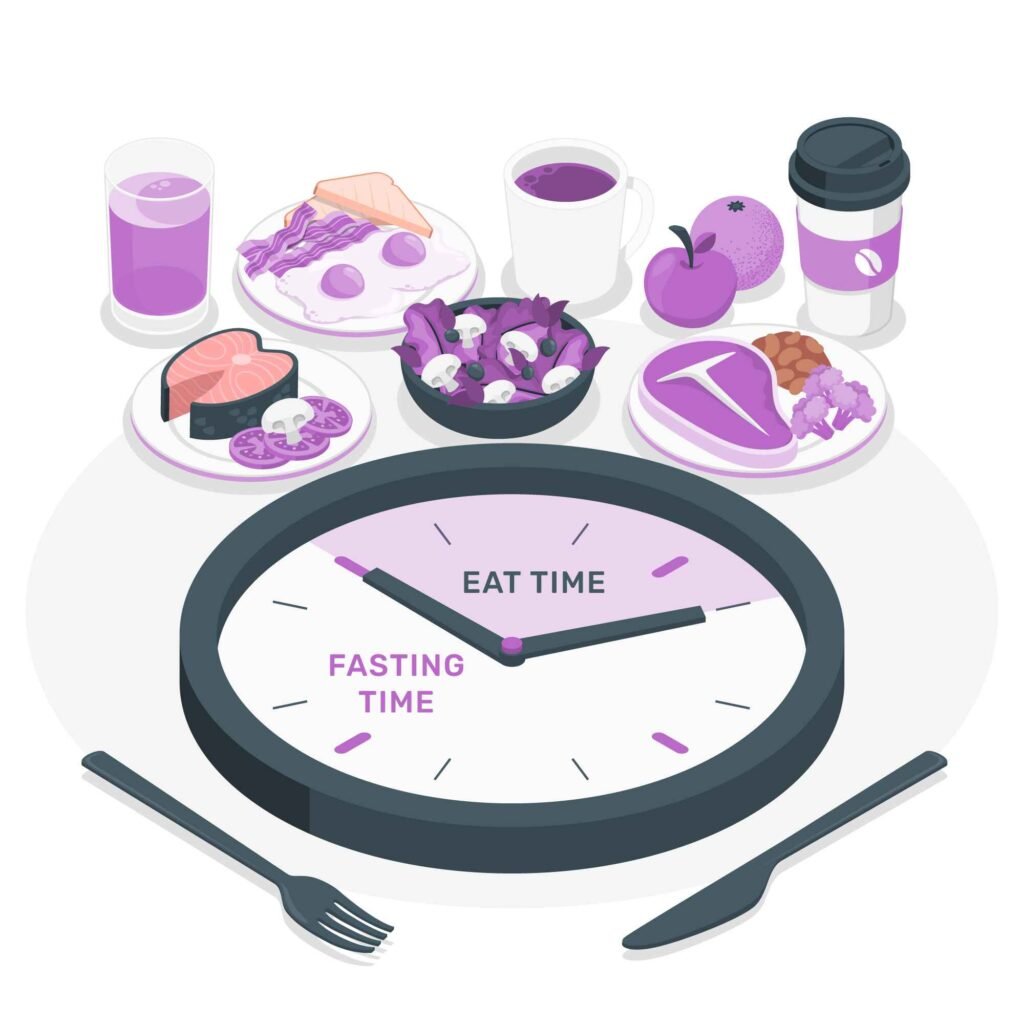
Sourdough and Fermented Foods
Introduction: Why Sourdough and Fermented Foods Are Taking Over Kitchens
In recent years, sourdough and fermented foods have gained immense popularity. But these aren’t just trends; they’re rooted in tradition and backed by science. Known for their unique flavors and profound health benefits, sourdough and fermented foods are staples in both modern and ancient diets.
This guide dives into their origins, benefits, and how you can incorporate these nutrient-rich foods into your daily routine for a healthier lifestyle.
Part 1: What Are Sourdough and Fermented Foods?
Understanding Sourdough
Sourdough bread is a unique type of bread made using a natural fermentation process. Instead of commercial yeast, sourdough relies on a starter—a mixture of flour and water that captures wild yeast and beneficial bacteria from the environment. This process results in bread that is not only flavorful but also easier to digest.
- Key Characteristics of Sourdough Bread:
- Tangy flavor profile
- Longer shelf life due to natural fermentation
- Dense yet airy texture
What Are Fermented Foods?
Fermented foods go through a natural process of lacto-fermentation, where natural bacteria feed on sugar and starch to create lactic acid. This process preserves the food and enhances its nutritional value.
Popular examples include:
- Kefir: A fermented dairy drink rich in probiotics.
- Kimchi: A spicy Korean side dish made from fermented vegetables.
- Kombucha: A fermented tea packed with gut-friendly bacteria.
- Yogurt: A staple probiotic-rich food.
- Sauerkraut: Fermented cabbage with a tangy taste.
Part 2: Health Benefits of Sourdough and Fermented Foods
1. Improved Digestive Health
The fermentation process breaks down compounds like gluten and antinutrients, making these foods easier to digest. Fermented foods, in particular, are loaded with probiotics—live bacteria that promote a healthy gut microbiome.
- Probiotics in Action:
- Strengthen the gut lining
- Improve nutrient absorption
- Reduce symptoms of bloating and constipation
2. Rich in Nutrients
Fermented foods and sourdough bread are nutrient powerhouses:
- Increased levels of B vitamins
- Enhanced bioavailability of minerals like iron, magnesium, and zinc
- Beneficial enzymes that aid in digestion
3. Supports Immune Function
A significant portion of the immune system is housed in the gut. By consuming probiotics from fermented foods and sourdough bread, you can boost your immunity and reduce the risk of infections.
4. Helps Regulate Blood Sugar Levels
Sourdough bread has a lower glycemic index compared to other types of bread. This means it causes a slower and more stable rise in blood sugar levels, making it a better choice for people with diabetes or those aiming to manage weight.
5. Natural Preservation
The fermentation process creates lactic acid, which naturally inhibits the growth of harmful bacteria. This not only extends shelf life but also eliminates the need for artificial preservatives.
Part 3: Why Sourdough and Fermented Foods Are a Culinary Game-Changer
Enhanced Flavor Profile
Fermentation enhances the flavor of food, creating complex and rich taste experiences. The tangy notes in sourdough bread or the umami punch of kimchi can elevate any dish.
Sustainable and Waste-Reducing
Making sourdough and fermenting foods at home is a sustainable practice. It reduces food waste, as overripe fruits and vegetables can often be used in fermentation.
Cultural and Historical Significance
From ancient Egyptian sourdough to Korean kimchi, these foods connect us to traditions and cultures around the world, bringing a sense of heritage to our tables.
Part 4: How to Make Sourdough Bread at Home
Step 1: Create Your Sourdough Starter
A sourdough starter is the heart of sourdough bread. Here’s a step-by-step guide to making your starter from scratch:
- Ingredients:
- 1 cup all-purpose flour
- 1/2 cup water (filtered or bottled)
- Instructions:
- Mix the flour and water in a glass jar. Stir until you get a thick paste.
- Cover loosely with a cloth to allow airflow.
- Leave it at room temperature for 24 hours.
- Feeding the Starter:
- Discard half of the starter daily and add 1 cup of flour and 1/2 cup of water.
- Stir and let it sit at room temperature.
- After 5-7 days, you should see bubbles and a tangy smell, indicating that your starter is ready.
Step 2: Prepare the Dough
- Ingredients:
- 3 1/2 cups all-purpose flour
- 1 1/2 cups water
- 1 cup active sourdough starter
- 2 teaspoons salt
- Instructions:
- In a large bowl, mix the starter, flour, and water.
- Let it rest for 30 minutes.
- Add the salt and knead the dough for 10 minutes.
- Cover and let it rise for 4-6 hours at room temperature, or until it doubles in size.
Step 3: Shape and Bake
- Shaping the Dough:
- Turn the dough onto a floured surface and shape it into a round loaf.
- Place it in a floured proofing basket or bowl.
- Final Proof:
- Cover and let it proof for another 2-4 hours.
- Baking:
- Preheat your oven to 450°F (230°C).
- Score the top of the dough with a sharp knife.
- Bake for 30-40 minutes until the crust is golden brown.
Tips for Success:
- Patience is key: Fermentation takes time.
- Temperature Control: A warm environment helps the dough rise better.
- Practice Makes Perfect: Don’t worry if your first loaf isn’t perfect; each attempt will improve your skills.
Part 5: How to Ferment Foods at Home
Fermented Vegetables: Step-by-Step Guide
Fermenting vegetables is simple and rewarding. Follow these steps to make your own batch:
- Ingredients:
- Fresh vegetables (cabbage, carrots, cucumbers, etc.)
- Non-iodized salt (sea salt or kosher salt)
- Water (filtered)
- Instructions:
- Prep the Veggies: Wash and chop your vegetables.
- Salt Brine: Dissolve 1-2 tablespoons of salt in 1 liter of water.
- Pack the Jar: Place the vegetables tightly into a sterilized jar. Pour the salt brine until the vegetables are fully submerged.
- Weight and Cover: Use a fermenting weight to keep the veggies under the brine. Cover the jar loosely with a lid.
- Fermentation: Let the jar sit at room temperature (65-75°F or 18-24°C) for 5-14 days. Taste daily after the first week to check the flavor.
- Storage: Once the desired taste is achieved, seal the jar tightly and store it in the fridge to slow fermentation.
Popular Fermented Foods to Try at Home
- Kimchi:
- Fermented spicy cabbage packed with garlic, ginger, and chili flakes.
- Sauerkraut:
- Classic fermented cabbage with a tangy taste.
- Fermented Pickles:
- Cucumbers fermented in a salt brine, offering a satisfying crunch.
- Kombucha:
- A fizzy, probiotic-rich tea fermented with a SCOBY (symbiotic culture of bacteria and yeast).
Part 6: Tips for Incorporating Sourdough and Fermented Foods into Your Diet
1. Start Small and Consistent
If you’re new to fermented foods, start with small servings. Your gut might need time to adjust to the influx of probiotics. Aim to include one serving of fermented foods per day, such as:
- A slice of sourdough bread for breakfast.
- A spoonful of sauerkraut as a side dish.
- A glass of kefir or kombucha in the afternoon.
2. Pair with Balanced Meals
Incorporate fermented foods into well-rounded meals. Pair sourdough bread with protein, healthy fats, and fiber-rich vegetables to optimize nutrient absorption.
Meal Ideas:
- Breakfast: Avocado toast on sourdough with a sprinkle of sesame seeds.
- Lunch: A bowl of vegetable soup with a side of kimchi.
- Dinner: Grilled chicken with a fermented pickle salad.
3. Experiment with Recipes
Get creative in the kitchen! Use sourdough and fermented foods in different recipes:
- Sourdough Pizza Crust: A healthier twist on classic pizza.
- Kimchi Fried Rice: A flavorful, probiotic-packed dish.
- Fermented Salsa: Add probiotics to your favorite Mexican dishes.
4. Snack Smart
Instead of processed snacks, opt for gut-friendly alternatives:
- Sourdough Crackers: Perfect with cheese or hummus.
- Yogurt Parfait: Layer yogurt with fruits, nuts, and seeds.
Part 7: Frequently Asked Questions About Sourdough and Fermented Foods
1. Is Sourdough Bread Healthier Than Regular Bread?
Yes, sourdough bread offers several health advantages over regular bread. Thanks to the natural fermentation process, sourdough contains:
- Lower Gluten Content: Easier to digest for those sensitive to gluten.
- Probiotics and Prebiotics: These promote gut health.
- Lower Glycemic Index: Helps regulate blood sugar levels.
- More Nutrients: Enhanced absorption of minerals like iron and magnesium.
Sourdough bread is a great option for those looking to enjoy bread without the digestive discomfort that commercial yeasted bread can sometimes cause.
2. Can I Eat Fermented Foods Every Day?
Absolutely! Eating fermented foods daily can boost your gut health and overall wellness. However, moderation is key. Start with small amounts to allow your digestive system to adapt. For example:
- 1 cup of yogurt or kefir
- A spoonful of sauerkraut or kimchi
- A slice of sourdough bread
These small servings can provide enough beneficial bacteria to support your digestive system.
3. How Do I Know If My Fermented Foods Have Gone Bad?
While fermentation preserves food, it can still spoil under certain conditions. Signs that your fermented food has gone bad include:
- Mold Growth: Fuzzy patches that are green, black, or pink.
- Off-Putting Smell: A strong, rancid odor rather than a pleasant tangy scent.
- Slimy Texture: If the brine or food becomes excessively slimy.
Always use clean utensils and ensure the food stays submerged in brine to avoid contamination.
4. Are Fermented Foods Safe for Everyone?
Fermented foods are safe for most people, but certain individuals should exercise caution:
- Those with Histamine Intolerance: Some fermented foods are high in histamines.
- Pregnant Women: Ensure fermented foods are properly prepared and stored.
- Immunocompromised Individuals: Consult a healthcare provider before consuming unpasteurized fermented foods.
Part 8: Common Mistakes to Avoid When Making Sourdough and Fermented Foods
1. Using Tap Water with Chlorine
Chlorinated water can kill the beneficial bacteria and yeast necessary for fermentation. Always use:
- Filtered Water
- Bottled Water
2. Not Feeding the Sourdough Starter Regularly
An active starter needs regular feeding to stay healthy. If left unfed, it may develop a foul smell or become inactive.
Tip: Feed your starter daily if kept at room temperature or weekly if stored in the refrigerator.
3. Skipping the Salt in Fermentation
Salt is crucial for:
- Preserving Vegetables
- Inhibiting Bad Bacteria
- Encouraging Beneficial Bacteria Growth
Always use the correct salt-to-water ratio to ensure successful fermentation.
4. Overlooking Temperature Control
Fermentation thrives at specific temperatures:
- Sourdough Starter: 70°F – 75°F (21°C – 24°C)
- Vegetable Fermentation: 65°F – 75°F (18°C – 24°C)
Too cold, and the process slows down. Too hot, and it can spoil quickly.
Part 9: The Science Behind Fermentation and Gut Health
The Role of Probiotics in the Gut Microbiome
Fermented foods are rich in probiotics—live microorganisms that offer numerous health benefits. A balanced gut microbiome is crucial for:
- Digestion
- Nutrient Absorption
- Immune Function
How Probiotics Work:
- They outcompete harmful bacteria.
- They produce short-chain fatty acids (SCFAs) that nourish gut cells.
- They reduce inflammation and improve overall gut health.
Fermentation and Mental Health
Did you know your gut health influences your mental health? This connection is known as the gut-brain axis. Probiotics from fermented foods can:
- Reduce Anxiety and Depression
- Improve Mood and Stress Levels
- Enhance Cognitive Function
Eating foods like yogurt, kefir, and kimchi regularly can have a positive impact on your mental well-being.
Boosting Immunity Through Fermentation
About 70% of your immune system is located in your gut. Probiotics from fermented foods:
- Strengthen the gut lining to prevent pathogens from entering the bloodstream.
- Promote the production of antibodies.
- Support overall immune response.
Regularly consuming sourdough and fermented foods is a natural way to boost your immunity.
Part 10: Easy Recipes Incorporating Sourdough and Fermented Foods
1. Sourdough Grilled Cheese with Kimchi
Ingredients:
- 2 slices of sourdough bread
- 1/2 cup kimchi
- 2 slices of cheddar cheese
- 1 tablespoon butter
Instructions:
- Butter the sourdough slices.
- Place cheese and kimchi between the slices.
- Grill on a skillet until golden brown.
Benefits: Probiotics from kimchi and fiber from sourdough for a healthy gut.
2. Yogurt and Berry Parfait
Ingredients:
- 1 cup yogurt (Greek or regular)
- 1/2 cup mixed berries (blueberries, strawberries)
- 1 tablespoon honey
- 1/4 cup granola
Instructions:
- Layer yogurt, berries, and granola.
- Drizzle with honey.
Benefits: A probiotic-rich, antioxidant-packed snack.
3. Fermented Pickle and Avocado Toast
Ingredients:
- 1 slice sourdough bread
- 1/2 avocado, smashed
- 2-3 fermented pickles, sliced
- A sprinkle of sea salt and chili flakes
Instructions:
- Toast the sourdough bread.
- Spread avocado and top with fermented pickles.
Benefits: Healthy fats, fiber, and probiotics in one bite.



